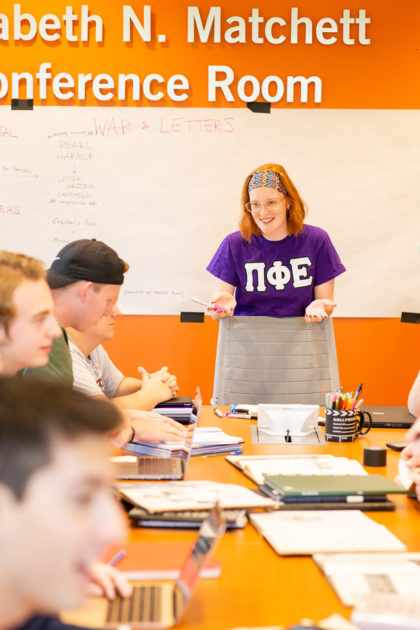After their successful documentary entitled Capital in the Sixties, the Immersion class will be delivering a documentary about Capital during World War II.
Last year, the Immersion class created Capital in the Sixties, a documentary film that explored what Capital was like during the mid-60s through mid-70s.
The next time period they decided to explore is Capital during the World War II era.
Mary Clare Kunkel, junior, is the director of the upcoming documentary.

“Right now, we’re heavily in the research stage of just getting as much as we can about the different years,” Kunkel said.
This stage of production involves a lot of digitization, which is the process of taking old documents and scanning them to be in a digital format.
Outside of the realm of filmmaking, digitization is very important. It ensures that old records and photographs live on past their physical conditions.
Once a stockpile of info has been gathered, the class will begin to decide what stories they want to tell through the documentary. Stories that may reveal the origins of things that we still see today around campus, such as the giant statue seen near Trinity Suites.
“So if you’re walking to the Trinity Suites, there’s this statue,” Kunkel said, “that’s a Holocaust rememberance statue that was put up in 1999.”
That statue was sculpted by Alfred Tibor, a Holocaust survivor that recently passed away in 2017.

Even though the class can’t personally interview Tibor, they still hope to tell his story and the impact that the sculpture has had.
In addition to gathering info and planning a story, the class is also diving into filming an enormous amount of b-roll, which is essentially video footage that supplements whatever is being talked about on screen.
B-roll is ranging from aerial shots of the campus to even hand-crafted animations.
“Sometimes we go and do animations to show off how progression happened or to present facts,” senior Blake Sheely and producer of the project, said.
Sheely also talked about the roadblocks that they’re coming up against.
“Seeing that a lot of ‘witnesses’ of this time are no longer with us, we’re going to have to turn to a lot of historians and maybe even children if possible,” Sheely said.
To aid in the search of interview subjects, Kunkel and two other members from the team contacted the Bexley Historical Society, who have possible connections to people that grew up in Bexley during the 30s and 40s.
Another roadblock that is anticipated is demoralisation. Sheely is hoping to keep everyone motivated and engaged throughout the semester to ensure that the project meets its deadline.
Neither Kunkel nor Sheely could provide a definitive release date, but they’re aiming to have it done by the end of November.
“It is a child that seems to be ready to start crawling,” Sheely said, “and sooner or later, it’s going to start running. So I’m looking forward to all that.”
The documentary’s website has not gone live yet, but more information will be available there when it does.
For our previous story on the Immersion class head here.


